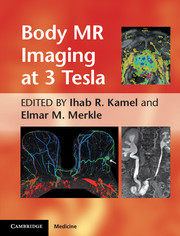Book contents
- Frontmatter
- Contents
- Contributors
- Foreword
- Preface
- Chapter 1 Body MR imaging at 3T: basic considerations about artifacts and safety
- Chapter 2 Novel acquisition techniques that are facilitated by 3T
- Chapter 3 Breast MR imaging
- Chapter 4 Cardiac MR imaging
- Chapter 5 Abdominal and pelvic MR angiography
- Chapter 6 Liver MR imaging at 3T: challenges and opportunities
- Chapter 7 MR imaging of the pancreas
- Chapter 8 MR imaging of the adrenal glands
- Chapter 9 Magnetic resonance cholangiopancreatography
- Chapter 10 MR imaging of small and large bowel
- Chapter 11 MR imaging of the rectum, 3T vs. 1.5T
- Chapter 12 Imaging of the kidneys and MR urography at 3T
- Chapter 13 MR imaging and MR-guided biopsy of the prostate at 3T
- Chapter 14 Female pelvic imaging at 3T
- Index
- Plate section
- References
Chapter 6 - Liver MR imaging at 3T: challenges and opportunities
Published online by Cambridge University Press: 05 August 2011
- Frontmatter
- Contents
- Contributors
- Foreword
- Preface
- Chapter 1 Body MR imaging at 3T: basic considerations about artifacts and safety
- Chapter 2 Novel acquisition techniques that are facilitated by 3T
- Chapter 3 Breast MR imaging
- Chapter 4 Cardiac MR imaging
- Chapter 5 Abdominal and pelvic MR angiography
- Chapter 6 Liver MR imaging at 3T: challenges and opportunities
- Chapter 7 MR imaging of the pancreas
- Chapter 8 MR imaging of the adrenal glands
- Chapter 9 Magnetic resonance cholangiopancreatography
- Chapter 10 MR imaging of small and large bowel
- Chapter 11 MR imaging of the rectum, 3T vs. 1.5T
- Chapter 12 Imaging of the kidneys and MR urography at 3T
- Chapter 13 MR imaging and MR-guided biopsy of the prostate at 3T
- Chapter 14 Female pelvic imaging at 3T
- Index
- Plate section
- References
Summary
Introduction
Increasing the main magnetic field strength for magnetic resonance (MR) imaging offers several theoretical advantages including higher signal to background noise, increased spectral separation, and better tissue contrast. The questions remain as to whether these theoretical advantages can be realized in the clinical setting and whether this implementation will lead to better lesion detection and characterization, more accurate diagnoses, and ultimately better patient outcome compared with 1.5T systems. While clinical 3T liver imaging is now more widely available, these questions still remain unanswered, as published scientific data are small. The answers will not only depend on the optimization of field strength-specific parameters but also on concomitant improvements in software and hardware.
- Type
- Chapter
- Information
- Body MR Imaging at 3 Tesla , pp. 67 - 81Publisher: Cambridge University PressPrint publication year: 2011



